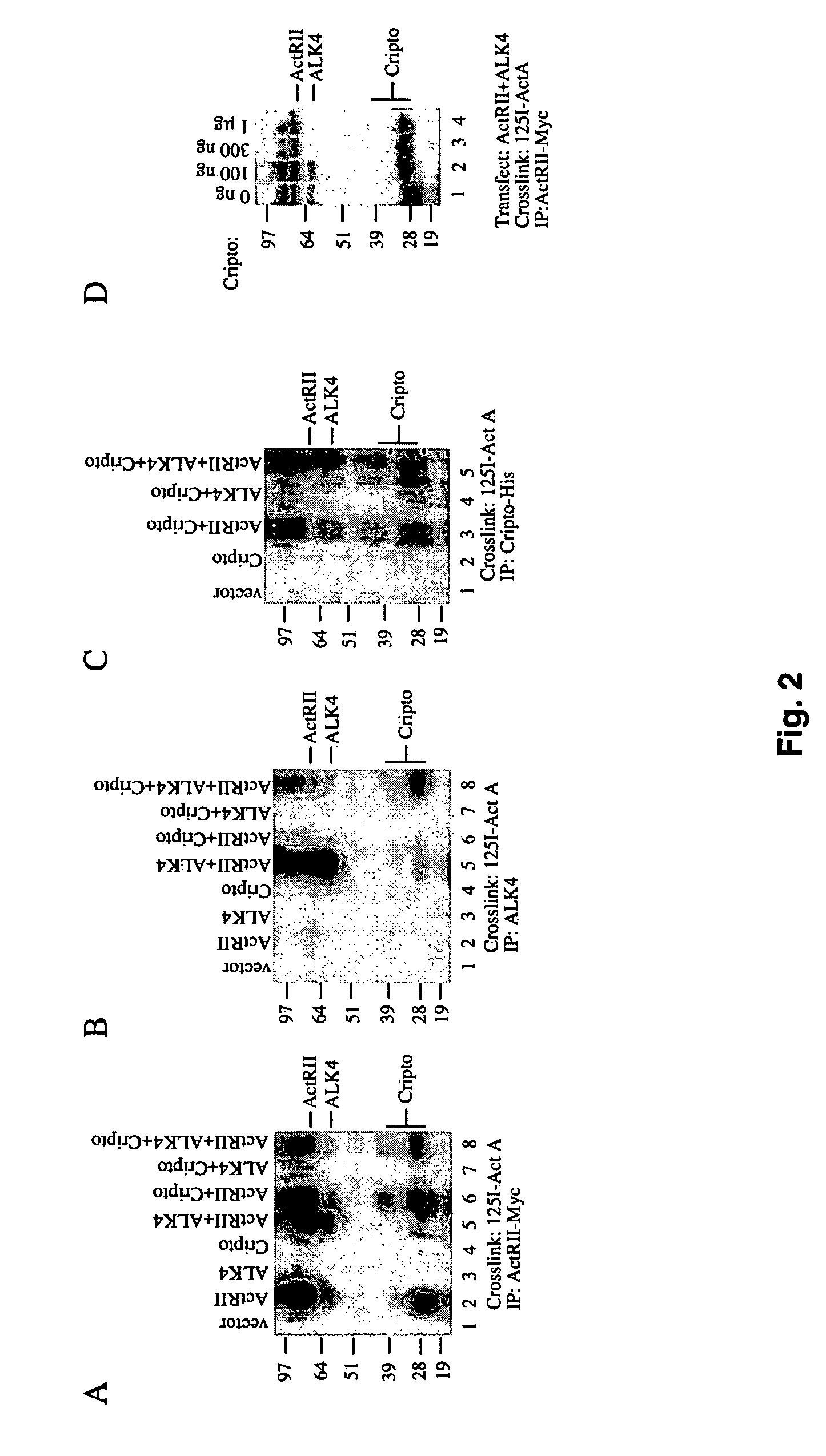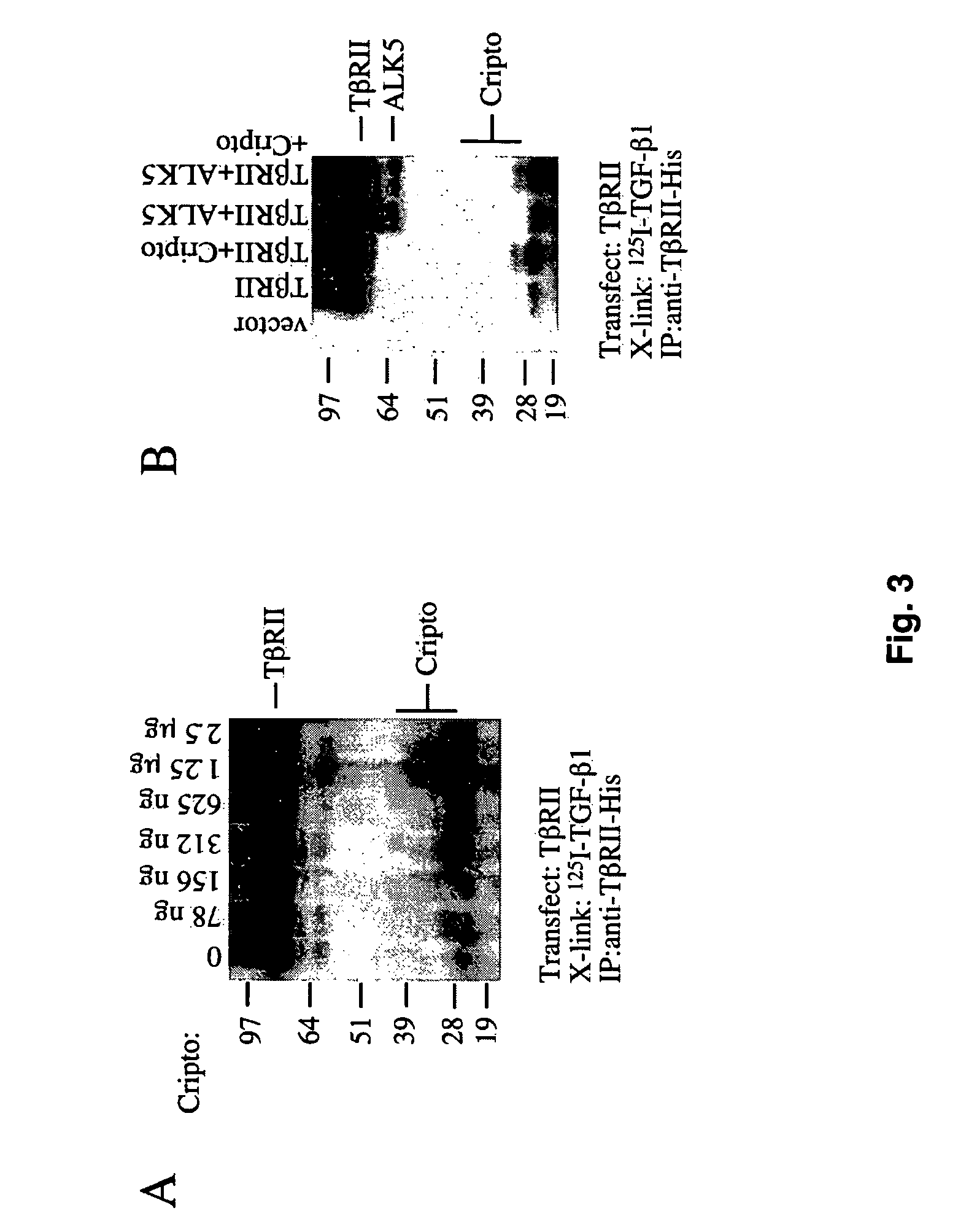Cripto antagonism of activin and TGF-b signaling
a technology of tgfb and activin, which is applied in the field of antagonism of activin and tgfb signaling, can solve the problems of loss of tbrii, increased tumor growth and metastasis, and disruption of nodal signaling, and achieve the effect of enhancing the formation of complexes
- Summary
- Abstract
- Description
- Claims
- Application Information
AI Technical Summary
Benefits of technology
Problems solved by technology
Method used
Image
Examples
example 1
Cripto Binds Activin in the Presence of ActRII and Competes with ALK4 for Activin•ActRII Binding
[0064]The ability of [125I]-activin-A to form crosslinked complexes with Cripto was tested in the presence or absence of activin receptors. FIG. 2 shows that when 293T cells were transfected with ActRII (FIG. 2A, lane 2) and then subjected to labeling and crosslinking with [125I]-activin-A followed by immunoprecipitation with an antibody directed against ActRII, an activin-ActRII crosslinked complex of ˜80 kDa was evident consistent with previous crosslinking results. The appearance of two ActRII•activin bands is routinely observed and is likely the result of differential glycosylation of ActRII.
[0065]Co-transfection of ActRII with ALK4 (FIG. 2A, lane 5) results in crosslinking of [125I]-activin-A to both receptor types as indicated by the appearance of the activin•ALK4 crosslinked complex at ˜60 kDa. No binding of [125I]-activin-A to Cripto was detected in the absence of activin type II ...
example 2
Cripto Binds TGF-b1 in the Presence of TbRII and Competes with ALK5 for TGF-b1•TbRII Binding
[0071]Similar to activin-A, TGF-b1 binds Cripto in the presence of its type II receptor TbRII. FIG. 3A shows crosslinking of [125I]-TGF-b1 to 293T cells transfected with TbRII and the indicated amounts of Cripto DNA. A prominent [125I]-TGF-b1•Cripto crosslinked band of ˜32 kDa appeared and increased in intensity as the amount of Cripto DNA transfected was increased. Fainter species of ˜40 kDa were also visible (FIG. 3A).
[0072]The effects of Cripto on the ability of [125I]-TGF-b1 to crosslink to its type I receptor ALK5 were examined. FIG. 3B shows that [125I]-TGF-b1 forms a crosslinked complex with its type II receptor of ˜85 kDa (FIG. 3B, lane 2) and that co-transfection of Cripto with TbRII results in the [125I]-TGF-b1•TbRII complex as well as the [125I]-TGF-b1•Cripto complex. When TbRII and ALK5 were co-transfected, [125I]-TGF-b1 labeled both receptors to yield complexes of ˜85 kDa and 60 ...
example 3
Cripto Blocks Activin-A and TGF-b1 Signaling in HepG2 Cells
[0073]HepG2 cells do not express Cripto and require transfected Cripto to respond to nodal signals. Therefore, the effects of transfected Cripto on activin-A and TGF-b1 signaling were tested in this cell line. Cripto and the activin / TGF-b responsive luciferase reporter construct 3TP-lux were transfected into HepG2 cells and the effect of Cripto on activin-A and TGF-b1-induced luciferase expression was measured. As shown in FIG. 4, activin-A and TGF-b1 caused dose-dependent increases in luciferase expression that were inhibited by Cripto. At maximal doses of these ligands there was an approximately four-fold reduction in signaling (FIG. 4A, B). As a control, the effect of Cripto on the ability of the activin-A paralog BMP7 to induce luciferase expression using the BMP-selective reporter BRE-luc has previously been tested. Although BMP7 induced luciferase expression in HepG2 cells in a dose-dependent manner, Cripto did not aff...
PUM
| Property | Measurement | Unit |
|---|---|---|
| temperature | aaaaa | aaaaa |
| pH | aaaaa | aaaaa |
| crystal structure | aaaaa | aaaaa |
Abstract
Description
Claims
Application Information
 Login to View More
Login to View More - R&D
- Intellectual Property
- Life Sciences
- Materials
- Tech Scout
- Unparalleled Data Quality
- Higher Quality Content
- 60% Fewer Hallucinations
Browse by: Latest US Patents, China's latest patents, Technical Efficacy Thesaurus, Application Domain, Technology Topic, Popular Technical Reports.
© 2025 PatSnap. All rights reserved.Legal|Privacy policy|Modern Slavery Act Transparency Statement|Sitemap|About US| Contact US: help@patsnap.com



